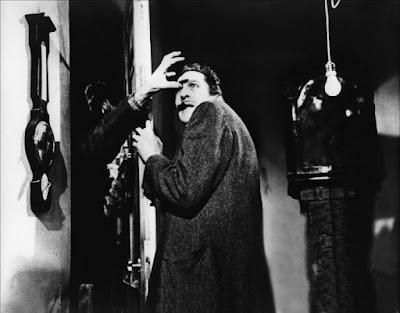Format: Streaming video from FreeVee on Fire!

Richard Matheson’s “I am Legend” has been adapted to film three times. The latest time was called I am Legend and was a massive blockbuster featuring Will Smith. Before that was The Omega Man with Charlton Heston. The first version was The Last Man on Earth from 1964, featuring Vincent Price. In my opinion, the adaptations have gotten steadily worse; The Last Man on Earth is not only the best of the three adaptations, it’s in many ways the one most loyal to the novel, in no small part because the screenplay was co-written by Matheson himself, even if he was disappointed enough in the result to asked to be listed under a different name.
In 1968, Robert Morgan (Vincent Price) lives by himself in the ruins of a city devastated by a terrible plague. We learn through a series of extended flashbacks that Morgan was a scientist working on finding a cure for a bacterial plague that has wiped out the planet’s population. However, he is not entirely alone, as it were. Those who have died of the plague have returned, and while physically and mentally weak, the bear all of the other classic hallmarks of vampires. They avoid their own reflection in mirrors, are repelled by garlic, and heal from wounds quickly, forcing Morgan to kill them by staking them. Because there are things that need to be discussed in detail, consider the rest of this under a spoiler warning—this movie is 60 years old, but that doesn’t change the fact that you may not want it spoiled.
Morgan spends his day combing the city, staking “vampires” and looking for supplies. He adorns his house with mirrors to keep the creatures at bay, but they sometimes manage to break those mirrors. He is desperate for food and supplies, especially fresh garlic. And, of course, he has to dispose of any bodies he encounters by taking them to a burn pit that has been essentially going since the beginning of the plague.
In the flashback, we learn of Morgan’s attempts to slow or prevent the plague. We also learn that his daughter (Christi Courtland) succumbed to the disease, followed by his wife Virginia (Emma Danieli). His co-worker and friend Ben Cortman (Giacomo Rossi-Stuart) also falls to the disease. This leaves Morgan as a sole human being until the day he meets Ruth Collins (Franca Bettoia), a survivor who may actually be infected herself.
The Last Man on Earth gets a number of things from the original story wrong, but also gets a great deal right. One of the biggest issues is that the film isn’t long enough to go into the detail needed to explain the plague. Essentially, there are two groups of people. The reason that bodies are being burned at the start of the plague is because the infection brings back the dead to a sort of semblance of undead life. Some, though, essentially survive the disease but are so severely changed by it that they are difficult to distinguish from the returned bodies. Morgan, in his effort to destroy what he sees as a terrible danger to himself, has been destroying both types of creature not knowing that in many cases he was killing living people.
While not everything in the film is scary, there are a few really good terror moments. The best comes in the flashback when Morgan’s wife Virginia dies. He determines that he will not allow her body to be burned in the pits, so instead he sneaks the body out of the house and buries her. That night, she comes back and attacks him. It’s a fantastic sequence, and if nothing before this indicated just how much this influenced Night of the Living Dead, this absolutely does—and it seems to have also given some notes to Stephen King, who clearly references this at the end of Pet Sematary. Sure, King might have been referencing Romero, but my guess is he knows the genre well enough to have known the original source.
It is in many ways the template for Romero’s film. Morgan barricades himself in his house and is subjected nightly to attacks by the creatures trying to get in. Admittedly, there are differences. The creatures can talk and use rudimentary tools, and while slow and uncoordinated, they aren’t entirely mindless. Additionally, they are only active at night, since the film maintains their essential similarity to vampires. It was an interesting choice to make them slow—in the original novel they are not, but the slow, uncoordinated movements of the creatures are absolutely the source of the signature gait and movement of Romero’s living dead.
The Last Man on Earth was shot in Rome, and while it appears that many of the actors are speaking English (and they likely are), their voices are dubbed, obviously in places. It’s a small issue, but an occasionally noticeable one.
My issues here are less with the film itself and more with its connection to the original work. One of the great strengths of the story is that the main character (Robert Neville in the book and both other film adaptations) is his realization that he is not the hero of the story, but the monster plaguing the existence of the infected survivors. He’s not a legend in a positive way, but the stuff of nightmares, the boogeyman that will have stories told about him around the campfire for generations to come. There’s the tiniest hint of this in this adaptation when Ruth reveals that she has been sent to watch him by those survivors, but the depth of that is missing and sorely missed.
Still, this is the best adaptation we’re likely to get for some time.
Why to watch The Last Man on Earth: It is very clearly the inspiration for Night of the Living Dead.
Why not to watch: While the best of the adaptations of “I am Legend,” it still punts the ending.
